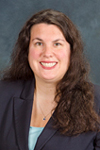Faculty
Primary Faculty

Neuroimaging techniques and computational tools to study the changes in brain functions and microstructures in animal models of human disorders

Multiphoton Laser Scanning Microscopy, novel in vivo imaging and measurement techniques, tumor biology, angiogenesis

Auditory Neuroscience; neurophysiological, behavioral, and computational studies of hearing; signal processing for hearing aids.



Flexible allocation of the brain’s limited processing resources in attention, perception, and working memory

Basic neurophysiology of schizophrenia and autism



Identifing molecular regulators of long-range trafficking of protein cargoes to distinct sub-domains of polarized cells, such as neurons

Medical, Graduate, and Undergraduate Education

The biology of neural progenitor cells in developing and adult mammalian brain

The electrophysiology of human sensation, perception and cognition, especially in naturalistic environments.

Development of teaching and learning tools in anatomy education

Role of cochlear outer hair cells in hearing and hearing loss

Auditory and multisensory processing in human listeners, using behavioral and electrophysiological methods.



Investigation of the molecules, receptors, and neural circuits that influence social interactions, including the actions of mammalian pheromones

The neural computations that enable the perception of natural sounds, such as speech and music


Mechanisms of neuroinflammation and neurodegeneration within the CNS, primarily Glial Cells and Vascular components of the brain.

Experimental and Computational Approaches to Sensory Perception


Neural control of movement; Computing and experiment control systems; Mathematics and statistics in neuroscience data analysis.

Organization and functions of the primate prefrontal cortex

Multisensory integration, social neuroscience and autism spectrum disorder


Exploring the understudied and novel mechanisms by which neuromodulators mediate the interactions between neurons, astrocytes, and microglia in both normal and disease states


Use virtual reality (VR), multimodal magnetic resonance imaging (MRI), and machine learning to elucidate the psychological and neural signatures of psychopathologies

Retinal degeneration and maladaptive plasticity in inner retinal circuits.

Clinical applications of advanced neuroimaging techniques such as functional MRI (fMRI), MR Spectroscopy (MRS), Diffusion Tensor Imaging (DTI), morphometry, Arterial Spin Labeling (ASL) and Dynamic Susceptibility Contrast (DSC)


Research Faculty
Secondary Faculty

Self-motion perception and adaptability of vestibular perception

Neurocognitive and communication deficits in autism and other developmental disabilities


The interaction of vision, the vestibular system, and human disease on motion perception.

Visual neuroscience; multi-sensory integration; neural coding; linking neurons to perception

How we process social information, make meaningful social connections, and how these processes vary across the full spectrum of health and psychiatric illness with a particular focus on schizophrenia-spectrum disorders using behavioral and neuroimaging (e.g., fMRI) methods.

Understanding the molecular basis of behaviors relevant to stress and the actions of fast antidepressant and anxiolytic drugs, aiming to identify specific circuits, neuronal subpopulations and synaptic mechanisms involved in these responses.

Mechanisms supporting conceptual processing, language, and action function in patients with brain tumor or epilepsy.




Understanding the neural mechanisms that mediate sensation and action with our hands.

Basal ganglia and degenerative diseases


Cochlear neurodegeneration, neural mechanisms for hearing in noise

Investigating if/how the production of rapid, coordinated movements requires control circuitry that can bypass sensory feedback delays by providing an estimate of the consequences resulting from a motor command.

Synaptic pharmaco-physiology of vestibular efferent-afferent interactions

Neural mechanisms of visual recovery after stroke; optical correlates and molecular substrates of corneal wound healing and nerve regeneration; LIRIC


Visual perceptual alterations in psychosis, behavioral psychophysics, eye-tracking, functional neuroimaging, and conceptual foundations of cognitive science

advance understanding of the neurophysiologic mechanisms underlying sensory perception in autism spectrum disorder

Peripheral nerve regeneration/degeneration and vascularized composite allotransplantation.


Optimizing the understanding, diagnosis and treatment of movement disorders with the use of neurophysiological techniques, and developing sustainable international collaborations that promote global equity in neurological education, research and patient care.

Pediatric neuromuscular disorders





Understand the natural statistics of the building blocks of communication

Visual psychophysics, high-resolution eye tracking and gaze-contingent technology to study spatial updating, foveal vision and control of attention and eye movements at the fine scale

Care and study of individuals with memory disorders


Visual Perception

Develop a research program concentrating on identifying genetic modifiers of environmental factors in disease etiology using a combination of Drosophila genetics, cell culture, and rodent models

Imaging single neurons and neuron networks in the living eye in health and disease.

Impairments of perceptual function and organization in schizophrenia and other neuropsychiatric disorders, their relationship to symptom emergence (e.g., in terms of altered predictive coding, or altered contextual modulation) and the possibility of performing visual remediation of low- and mid-level visual disturbances in these conditions.

Neurotoxicology, Etiology of neurobehavioral disease, Endocrine dysfunction, Synergistic Toxicity.

Understanding the neural circuit mechanisms that generate and shape complex feeding behaviors


Schizophrenia, with a particular interest in the pathophysiology of positive symptoms



Emeritus Faculty



Neuro-immune interactions, medical education, and faculty development



Cortical Circuitry Underlying Memory-Guided Sensory Decisions

Adjunct Faculty


Visual Neuroscience; Learning, Motivation and Reward Guided Decision-Making; Emotion; Amygdala; Deep Brain Stimulation

Craniofacial development

Assistant Professor of Neurobiology at St. Mary's College of Maryland

Attention multisensory integration sensory and perceptual processing executive function

Cognitive and neuropsychological properties of human memory

Juvenile stress and the development of the amygdala.
Many of our Primary and Secondary Research Faculty, in conjunction with their ongoing research projects, maintain essential teaching roles across multiple fields at the University. These roles include medical education, graduate education and undergraduate education, thus providing a link between current research advancements and students at all levels of University education.












